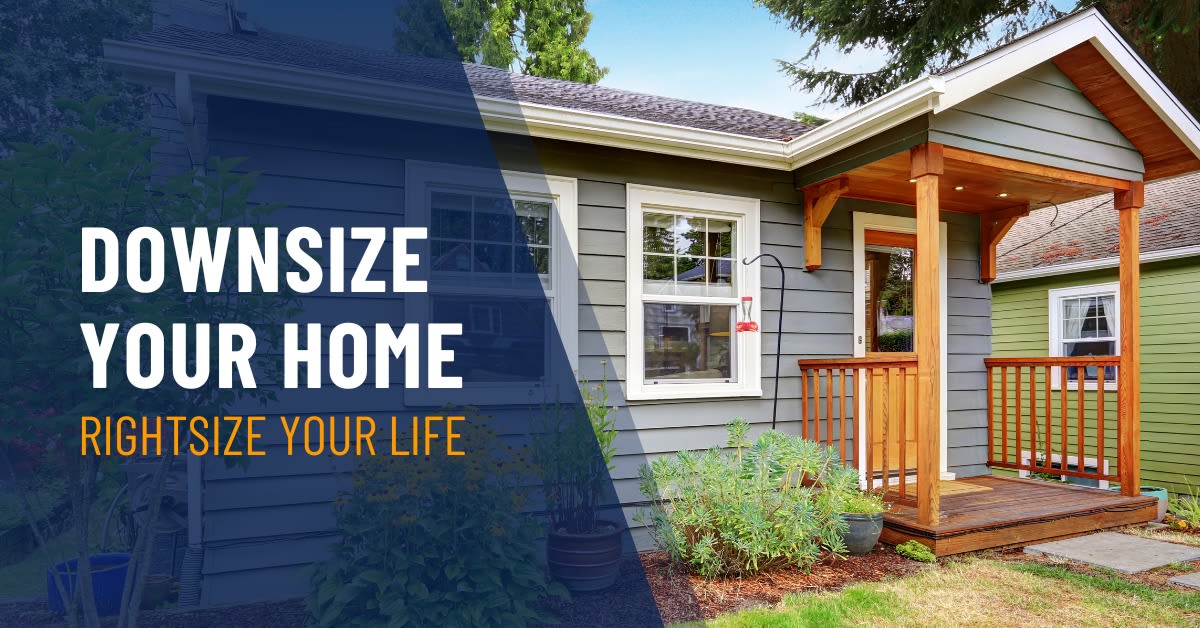It can be challenging to say goodbye when you've lived somewhere for many years. But if you (or a loved one) currently have a home that is bigger than necessary or is too high maintenance, it may be time to trade unused square footage for a smaller, more manageable space.
Take it from the downsizers who’ve been there: Although living small might require some adjustments, it can also be liberating––especially if you're in a stage where past responsibilities have given way to new possibilities and adventures.
According to real estate journalist and author Sheri Koones, many downsizers report feeling invigorated by the change. “It scares people to think of moving into a smaller space,” said Koones to the Associated Press. “But every person I interviewed who has made the transition says they are so happy they did.”1
The key is to find somewhere you can live well and move around comfortably without feeling overly restricted. If you like the idea of aging in place or are already in your golden years, you may also want to look for signs that a new home can conveniently age with you.
With that in mind, we recommend focusing your search on three key factors: desired lifestyle, optimal design, and long-term accessibility. Read on for specific tips, then call us for a free consultation. We can help you identify the homes best suited to living large with less.
|
Do you have a loved one whose housing needs have changed? |
DESIRED LIFESTYLE
The best part of downsizing is the lifestyle you unlock when you trade square footage for convenience. With fewer chores and home maintenance tasks, you can channel your energy into other pursuits instead.
For example, instead of spending your afternoons working in the yard or cleaning, you can catch up on the news, read a bestseller, start a new craft project, or pursue other hobbies. You may even be able to travel or spend more time with friends and family.
Research shows that individuals over 65 report more life satisfaction when they can spend time around children, talk with friends, socialize in community centers, volunteer, or engage in hobbies. But that can be hard to do regularly when you've got a home that needs constant attention or you live far from your community.2
As you compare potential homes, consider the type of lifestyle you envision. Do you plan to travel? If so, a home with extra security, such as a condominium or gated community, may give you some welcome peace of mind. Or do you plan to have friends and family stay overnight? In that case, you may look for a floor plan with flex space or a property with access to separate guest suites.
Alternatively, a senior community that offers catered meals and housekeeping may be a better choice if you or a spouse need extra support.
Action item: Grab a pen and take some time to envision what your ideal future might look like. Write down the activities and hobbies you hope to add to your life or continue going forward, as well as the chores and responsibilities you'd love to drop. We can use those answers to help shape your house hunt.
OPTIMAL DESIGN
Even though your new home will be smaller, that doesn't mean it has to feel cramped. Koones explains, “The key is to have a home that is efficiently designed, both in terms of energy use and space.”1
Look for features that can help make a space feel bigger, like high ceilings, large windows, and an open layout.
Built-in shelving that extends to the ceiling can also make a small room feel more expansive by helping to draw the eye upward. The same goes for highly placed window treatments and striped or mural-style wallpaper, says interior designer Kati Greene Curtis. “You’ll feel like you’re walking into the scene,” said Curtis to the Washington Post.3
Efficient layouts with flexible, multi-purpose rooms and few, if any, hallways work exceptionally well for small-scale living. You can also limit dead space in a home by removing layouts with awkward corners, unusable nooks, and other space-eating design elements.
In addition, look for features that support a more straightforward, lower-maintenance lifestyle, such as easy-care floors, durable countertops, and bare walls with little crown molding.
Don’t write off a home too soon if it feels narrow or congested because of outdated design or poor staging. Cosmetic issues that visually shrink a space are often easy to fix.
For example, painting a room a lighter shade instantly makes it feel bigger. Adding mirrors and swapping out heavy curtains for sheer ones can also be effective. Plus, multipurpose furniture with hidden storage is a great way to maximize space.
Action item: Make a note of your must-keep furniture and other items. Then, pull out a measuring tape and write down the dimensions. Once it's time to visit homes, we'll have a more accurate sense of what will fit and how much space you’ll need.
To get your creative juices flowing, you may also want to flip through some design magazines specializing in compact living or catalogs featuring space-saving furniture and accessories. If you give us a list of your favorite features, we can use it to pinpoint homes that are a good match.
LONG-TERM ACCESSIBILITY
Buying a home that you can age well in can be a great way to boost your health prospects and happiness. According to the U.S. Department of Housing and Urban Development (HUD), homeowners who age in place instead of in an institutional environment not only save money over time, they also enjoy greater health and emotional benefits.4
Aging in place is also popular. According to survey findings from the National Poll on Healthy Aging, the vast majority of adults between 50 and 80 would prefer to age in their own homes.5
However, even though many adults want to age in place, only 34% of surveyed adults currently live in a home with the features to make it possible.
If you're already in the second half of your life, it's wise to prioritize accessibility now, even if you're highly mobile.
Choosing an accessible home will improve your odds of staying put for longer. You never know when you might need an accessible light switch, handrails in the bathroom, or a seat in the shower, says Sheri Koones. “Yes, older people with disabilities need them, but even younger people break a leg skiing or have situations where they want a barrier-free shower.”1
As you consider your options, try to imagine what your needs might be as you get older and be proactive in identifying potential obstacles, recommends the National Council on Aging (NCOA).6
For example, a single-level home or one with wide enough stairs for a stair lift or access to an elevator may be a more practical choice than a home with many narrow stairs. Alternatively, a house with at least one ground-level bedroom and bathroom may work well for you.
Consider your needs outside the home, as well: If you frequently visit the doctor, grocery store, or community center, for example, then you may benefit from choosing a property nearby.
Action item: Review the checklist below, adapted from the National Institute on Aging’s home safety worksheet, or download the full version from the agency’s website.7 Highlight the items that are most important to you. We can reference these guidelines as we consider potential homes and suggest ways to adapt a property to meet your current or future requirements.
|
HOME SAFETY CHECKLIST 7 |
|
● If a walker or wheelchair is needed, can the entrances to the house be modified — perhaps by putting in a ramp to the front door? ● Are there any tripping hazards at exterior entrances or inside the house? ● Are the hallways and doorways wide enough to accommodate a wheelchair if needed? ● Does the home have at least one ground-floor bedroom and bathroom? ● Are there any staircases, and if so, could they accommodate a stair lift? ● Is the house well-lit, inside and out, particularly at the top and bottom of stairs? ● Could handrails be installed on both sides of the staircase? ● Is there at least one stairway handrail that extends beyond the first and last steps on each flight of stairs? ● Are outdoor steps sturdy and textured to prevent falls in wet or icy weather? ● Are there grab bars near toilets and in the tub or shower? ● Have a shower stool and hand-held shower head been installed to make bathing easier? ● Is the water heater set at 120° F to avoid scalding tap water? ● Are there safety knobs and an automatic shut-off switch on the stove? ● Have smoke and carbon monoxide alarms been installed near the kitchen and in all bedrooms? ● Are there secure locks on all outside doors and windows? |
BOTTOMLINE
You don't have to compromise on comfort to downsize successfully. We can help you strategize your next move and identify the best new home for you—whether that's a smaller home for rent or another one to call your own. We take pride in offering a full-service real estate experience and assisting our clients through all stages of the real estate journey. And we’ll go the extra mile to maximize your current home's sales price to set you up for financial security.
The above references an opinion and is for informational purposes only. It is not intended to be financial, legal, or tax advice. Consult the appropriate professionals for advice regarding your individual needs.
Sources:
- Associated Press (AP) -
https://apnews.com/article/lifestyle-f094372b46bae82020c174907eb953c0 - Healthcare (Basel) -
https://www.ncbi.nlm.nih.gov/pmc/articles/PMC10671417/ - Washington Post -
https://www.washingtonpost.com/home/2023/02/07/make-small-room-appear-larger/ - HUD User -
https://www.huduser.gov/portal/periodicals/em/fall13/highlight2.html - National Poll on Healthy Aging - https://www.healthyagingpoll.org/reports-more/report/older-adults-preparedness-age-place
- National Council on Aging (NCOA) - https://www.ncoa.org/adviser/medical-alert-systems/downsizing-for-aging-in-place/
- National Institute of Health (NIH) - https://www.nia.nih.gov/sites/default/files/2023-04/worksheet-home-safety-checklist_1.pdf



